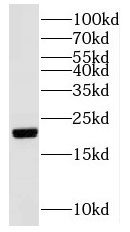Products
NUDT16 antibody
| Synonyms: | U8 snoRNA-decapping enzyme|IDP phosphatase (IDPase)|Inosine diphosphate phosphatase|Nucleoside diphosphate-linked moiety X motif 16 (Nudix motif 16)|Nudix hydrolase 16|U8 snoRNA-binding protein H29K|m7GpppN-mRNA hydrolase|NUDT16 antibody | ||
| Catalogue No.: | FNab05901 | Reactivity: | Human |
| Host: | Rabbit | Tested Application: | ELISA, WB, IHC, IP, IF |
| Clonality: | polyclonal | Isotype: | IgG |
| Size | Price |
|---|---|
| 100µg | Inquiry |
- SPECIFICATIONS
- FIGURES
- CONDITIONS
- FAQS
- Product Name
- NUDT16 antibody
- Catalogue No.
- FNab05901
- Size
- 100μg
- Form
- liquid
- Purification
- Immunogen affinity purified
- Purity
- ≥95% as determined by SDS-PAGE
- Clonality
- polyclonal
- Isotype
- IgG
- Storage
- PBS with 0.02% sodium azide and 50% glycerol pH 7.3, -20℃ for 12 months(Avoid repeated freeze / thaw cycles.)
- Immunogen
- nudix(nucleoside diphosphate linked moiety X)-type motif 16
- Alternative Names
- U8 snoRNA-decapping enzyme|IDP phosphatase (IDPase)|Inosine diphosphate phosphatase|Nucleoside diphosphate-linked moiety X motif 16 (Nudix motif 16)|Nudix hydrolase 16|U8 snoRNA-binding protein H29K|m7GpppN-mRNA hydrolase|NUDT16 antibody
- UniProt ID
- Q96DE0
- Observed MW
- 21 kDa
- Tested Applications
- ELISA, WB, IHC, IP, IF
- Recommended dilution
- WB: 1:1000-1:4000; IP: 1:500-1:2000; IHC: 1:20-1:200; IF: 1:20-1:200
 HeLa cells were subjected to SDS PAGE followed by western blot with FNab05901(NUDT16 antibody) at dilution of 1:2500
HeLa cells were subjected to SDS PAGE followed by western blot with FNab05901(NUDT16 antibody) at dilution of 1:2500
 IP Result of anti-NUDT16 (IP:FNab05901, 3ug; Detection:FNab05901 1:1000) with HEK-293 cells lysate 2400ug.
IP Result of anti-NUDT16 (IP:FNab05901, 3ug; Detection:FNab05901 1:1000) with HEK-293 cells lysate 2400ug.
 Immunohistochemistry of paraffin-embedded human kidney tissue slide using FNab05901(NUDT16 Antibody) at dilution of 1:50
Immunohistochemistry of paraffin-embedded human kidney tissue slide using FNab05901(NUDT16 Antibody) at dilution of 1:50
- Background
- RNA-binding and decapping enzyme that catalyzes the cleavage of the cap structure of snoRNAs and mRNAs in a metal-dependent manner. Part of the U8 snoRNP complex that is required for the accumulation of mature 5.8S and 28S rRNA. Has diphosphatase activity and removes m7G and/or m227G caps from U8 snoRNA and leaves a 5'monophosphate on the RNA. Catalyzes also the cleavage of the cap structure on mRNAs. Does not hydrolyze cap analog structures like 7-methylguanosine nucleoside triphosphate(m7GpppG). Also hydrolysis m7G-and m227G U3-capped RNAs but with less efficiencies. Has broad substrate specificity with manganese or cobalt as cofactor and can act on various RNA species. Binds to the U8 snoRNA; metal is not required for RNA-binding. May play a role in the regulation of snoRNAs and mRNAs degradation. Acts also as a phosphatase; hydrolyzes the non-canonical purine nucleotides inosine diphosphate(IDP) and deoxyinosine diphosphate(dITP) as well as guanosine diphosphate(GDP), deoxyguanosine diphosphate(dGDP), xanthine diphosphate(XDP), inosine triphosphate(ITP) and deoxyinosine triphosphate(ITP) to their respective monophosphate derivatives and does not distinguish between the deoxy-and ribose forms(PubMed:20385596, PubMed:26121039). The order of activity with different substrates is IDP > dIDP >> GDP = dGDP > XDP = ITP = dITP(PubMed:20385596). Binds strongly to GTP, ITP and XTP. Participates in the hydrolysis of dIDP/IDP and probably excludes non-canonical purines from RNA and DNA precursor pools, thus preventing their incorporation into RNA and DNA and avoiding chromosomal lesions(PubMed:20385596).
How many times can antibodies be recycled?
First, usually it's not suggested to recycle antibodies. After use, buffer system of antibodies has changed. The storage condition of recycled antibodies for different customers also varies. Thus, the performance efficiency of recycled antibodies can’t be guaranteed. Besides, FineTest ever conducted the antibody recycling assay. Assay results show recycling times of different antibodies also varies. Usually, higher antibody titer allows more repeated use. Customers can determine based on experimental requirements.
Notes: After incubation, we recycle rest antibodies to centrifuge tube and store at 4℃. High titer antibodies can be stored for a minimum of one week. Reuse about three times.
What are components of FineTest antibody buffer?
Components of FineTest antibody buffer are usually PBS with proclin300 or sodium azide, BSA, 50% glycerol. Common preservative is proclin300 or sodium azide, which is widely applied in the lab and industry.
How about the storage temperature and duration of FineTest antibodies?
Most antibodies are stored at -20℃. Directly-labeled flow cytometry antibodies should be stored at 2 - 8℃. The shelf life is one year. If after sales issues for purchased antibodies appear, return or replacement is available. Usually, antibodies can be still used after the one-year warranty. We can offer technical support services.
Is dilution required for FineTest antibodies? What’s the dilute solution?
Directly-labeled flow cytometry antibodies are ready-to-use without dilution. Other antibodies are usually concentrated. Follow the dilution ratio suggested in the manual. Dilute solution for different experiments also varies. Common antibody dilution buffers are acceptable(e.g. PBST, TBST, antibody blocking buffer).
How to retrieve antibodies for immunohistochemistry?
Common retrieval buffers: Tris-EDTA Buffer(pH 9.0); Citrate Buffer(pH 6.0)
Heat induced antibody retrieval:
Method 1: Water-bath heating: Put the beaker with retrieval buffer and slide in the boiling water bath. Keep the boiling state for 15min. Naturally cool to room temperature;
Method 2: Microwave retrieval: Put the beaker with retrieval buffer and slide in the microwave oven. Heat at high power for 5min, Switch OFF for 3min, Heat at medium power for 5min. Naturally cool to room temperature.
How to choose secondary antibodies?
(1) Secondary antibodies react with primary antibodies. Thus, secondary antibodies should be against host species of primary antibodies. E.g. If the primary antibody is derived from rabbit, the relevant secondary antibody should be against rabbit. E.g. goat anti rabbit or donkey anti rabbit.
(2) Choose secondary antibody conjugates according to the experimental type, e.g. ELISA, WB, IHC etc. Common enzyme conjugated secondary antibodies are labelled by HRP, AP etc. Fluorescin or dye labelled secondary antibodies are applied in immunofluorescence and flow cytometry(e.g. FITC, Cy3).
